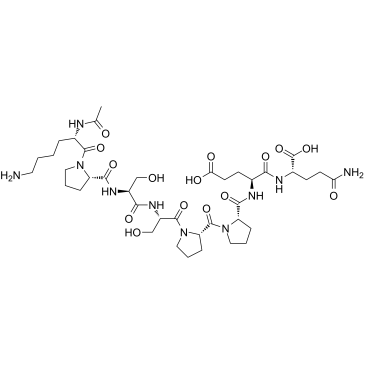| Description |
Angstrom6 (A6 Peptide) is an 8 amino-acid peptide derived from single-chain urokinase plasminogen activator (scuPA) and interferes with the uPA/uPAR cascade and abrogates downstream effects. Angstrom6 binds to CD44 resulting in the inhibition of migration, invasion, and metastasis of tumor cells, and the modulation of CD44-mediated cell signaling[1][2].
|
| Related Catalog |
|
| In Vitro |
Angstrom6 is effective at blocking the migration of the OVCAR8, OVCAR3, ES2, IGROV-1, MDA-MB-468, and MDA-MB361 cells with IC50s in the range of 10 to 100 nM[3]. Angstrom6 potentiates the CD44-dependent adhesion of cancer cells to hyaluronic acid and activated CD44-mediated signaling, as evidenced by focal adhesion kinase and MAP/ERK kinase phosphorylation[3].
|
| In Vivo |
Angstrom6 (100 mg/kg; s.c. twice daily) reduces the number of lung foci generated by the i.v. injection of B16-F10 melanoma cells by 50%[3]. Animal Model: C57Bl/6 mice (bearing B16-F10 cells)[3] Dosage: 100 mg/kg Administration: S.c.; twice a day for 11 days Result: Reduced the number of lung nodules and reduced the number of lung metastases to 50% of control.
|
| References |
[1]. Ghamande SA, et al. A phase 2, randomized, double-blind, placebo-controlled trial of clinical activity and safety of subcutaneous A6 in women with asymptomatic CA125 progression after first-line chemotherapy of epithelial ovarian cancer. Gynecol Oncol. 2008;111(1):89-94. [2]. Finlayson M. Modulation of CD44 Activity by A6-Peptide. Front Immunol. 2015;6:135. Published 2015 Mar 30. [3]. Piotrowicz RS, et al. A6 peptide activates CD44 adhesive activity, induces FAK and MEK phosphorylation, and inhibits the migration and metastasis of CD44-expressing cells. Mol Cancer Ther. 2011;10(11):2072-2082.
|
